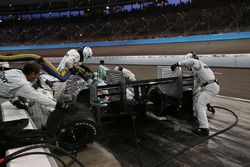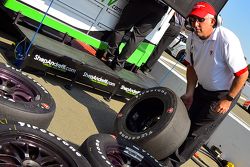Firestone still investigating Penske tire deflations at Phoenix
Firestone Racing has not yet reached a conclusion about what caused the tire deflations that cost Helio Castroneves and Juan Montoya a shot at victory in Phoenix last Saturday night.

Photo by: IndyCar Series














The Team Penske-Chevrolets of polesitter Castroneves, in the first stint, and Montoya, in the second stint, were leading when their right-front tires let go, obliging a slow lap and an extra pit stop. The pair raced their way back to finish 11th and ninth, respectively.
Dale Harrigle, Bridgestone Americas’ chief engineer and manager of race tire development, told Motorsport.com: “Unfortunately at this moment, we cannot confirm anything.
“All the right-side tires used in the race are on their way back to our Akron [Ohio] base. Most of our engineering staff is here at Indianapolis for this safety test, so it’s going to be a while before we get a chance to analyze the tires in great detail and draw any conclusions.”
Although there were numerous cases of cut tires in testing at Phoenix back in February, the track was washed down the day before practice got underway last weekend, and Montoya’s and Castroneves’ issues were the only ones Harrigle was made aware of during the race.
“Both IndyCar and Phoenix International Raceway did a great job in getting the track clean for the race,” agreed Harrigle, “so if they were just cuts to the tires on the #2 and #3 cars, they were the exception.
“One of our engineers had a meeting with Team Penske this morning and talked through the incidents, and shared what we know. And Penske have supplied us with vehicle data and usage data. So we’re working closely with the team to determine the root cause.”
Firestone ready to help tweak Phoenix spec
Harrigle confirmed that Firestone is prepared to work with IndyCar to help adjust the specification of its tires for next year’s race at Phoenix.
He stated: “As we always are, we’re completely interested in working with IndyCar for their future plans. If they want to do something different at PIR for 2017, whether that’s less downforce or more tire degradation – however they want to approach the event – we’d absolutely work with them.
“And if we want to bring something different back to Phoenix, we certainly can. We used our Milwaukee tire this year, and feedback seemed to be all over the map. But [race-winner] Scott Dixon and Tony Kanaan were very happy with the tires. Some drivers said they went to understeer, others said they went loose, so overall I think the performance of the tires was good.
“But like I say, we’re 100 percent happy to work with the series to discuss any changes they may want to make for 2017.”
The Catch-22 on tire degradation
Although some of the top IndyCar drivers have regularly expressed a desire to run on tires that heavily degrade over the course of a stint on ovals, Harrigle agreed that would likely create more “marbles” and therefore any caution periods could be extended as IndyCar sought to clear rubber debris.
“I would say that’s accurate, yes,” said Harrigle. “There would be more marbles and for instance at Phoenix, it would take that second lane out of action.
“So we have to be very deliberate and very progressive in what we do to make sure we’re striking that balance between a tire that goes off a bit over a stint, but also keeps the track relatively clean so that second line is available to the drivers. It’s a balancing act, for sure.”
The tires used at Texas Motor Speedway in 2012, that degraded enough that some cars’ lap speeds dropped from 210 to 195mph over the course of a stint, are still held in high regard by the drivers able to best preserve their rubber, since they did not appear to create a surfeit of marbles. However, Harrigle explained the circumstances could not be compared.
“I think part of that was because the cars were run with a very low-downforce package, and also because the tires for Texas aren’t soft like at a one-mile oval,” he said. “When you tear the rubber off a mile-oval tire, the rubber tends to bunch up and stick to itself creating those marbles, like you see at a Long Beach or a St. Petersburg.
“The superspeedway tire [for Texas, Pocono, and Indianapolis] is much, much harder and when it abrades across the track surface, the rubber particles come off more like a pencil eraser or sawdust – very fine grain that doesn’t create those marbles. So at Texas, all lanes remained usable.”
Be part of Motorsport community
Join the conversationShare Or Save This Story
Subscribe and access Motorsport.com with your ad-blocker.
From Formula 1 to MotoGP we report straight from the paddock because we love our sport, just like you. In order to keep delivering our expert journalism, our website uses advertising. Still, we want to give you the opportunity to enjoy an ad-free and tracker-free website and to continue using your adblocker.























Top Comments